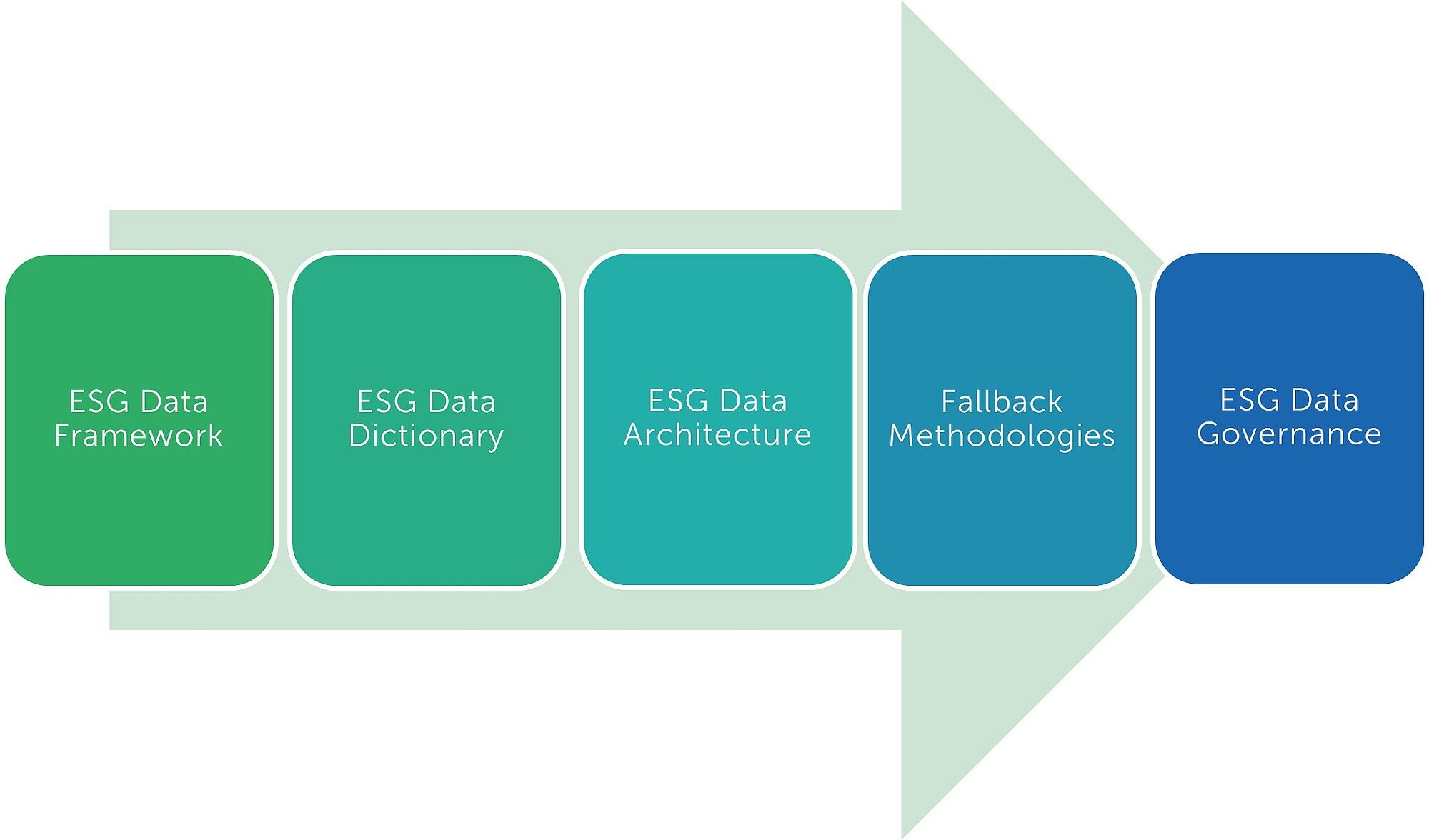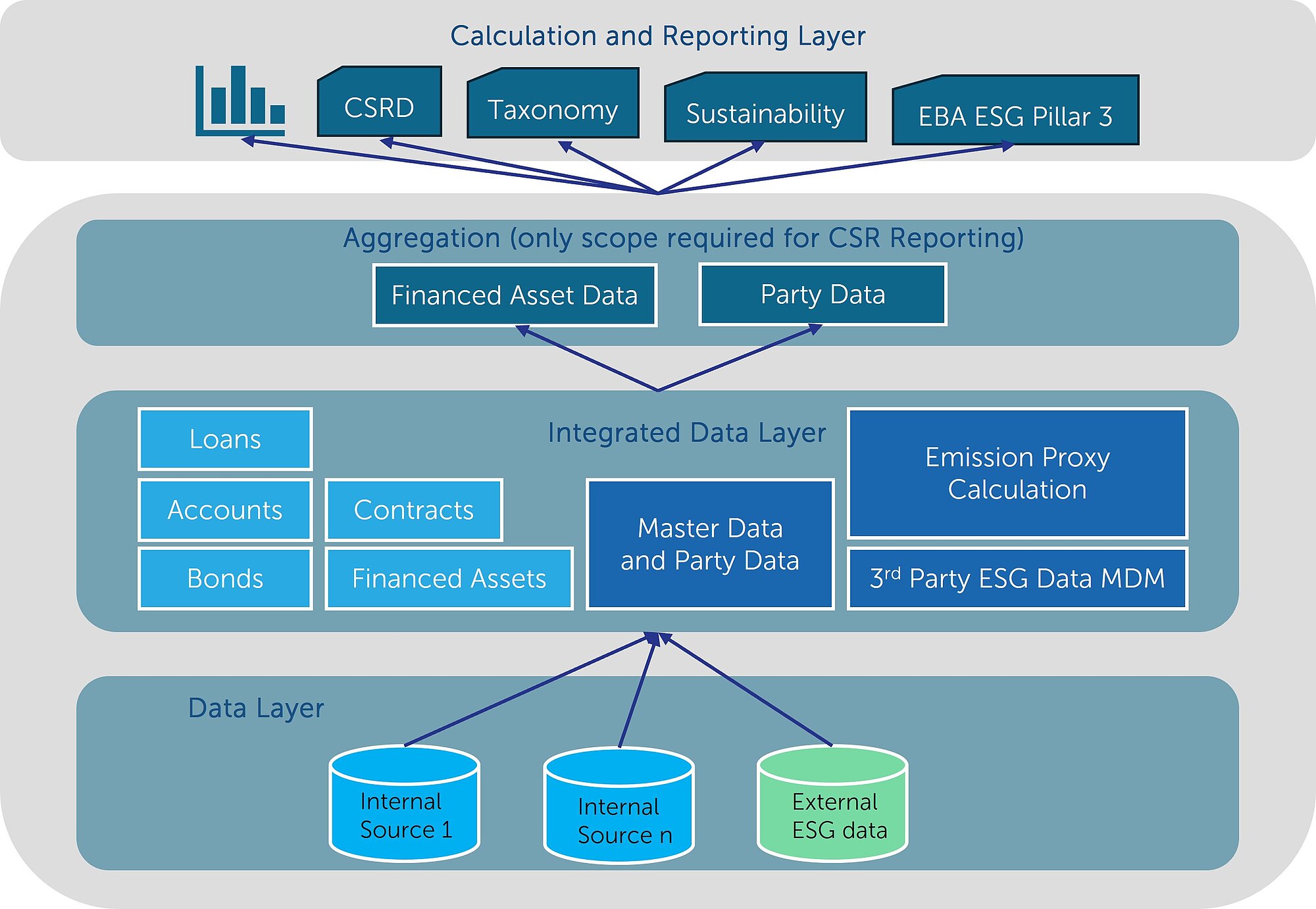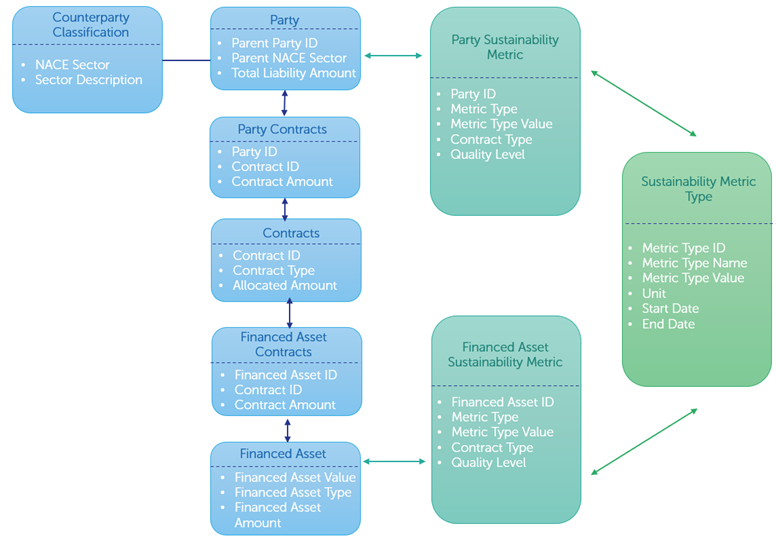How Finalyse can help
NAVIGATE ESG DATA MANAGEMENT AND REPORTING SEAMLESSLY WITH OUR EXPERT GUIDANCE.
Designed to meet Corporate Sustainability Reporting Directive (CSRD) requirements
Designed to develop and implement climate risk measurement methodologies, such as stress testing and portfolio alignment methods
Written by Meghna Jain (Consultant), edited by Hugo Weitz (Principal Consultant)
Introduction
Environmental, Social, and Governance (ESG) factors have become crucial metrics for stakeholders, including investors, customers, and regulatory bodies. Effective ESG data management is essential for accurate and transparent ESG reporting, enabling organizations to demonstrate their commitment to sustainability, social responsibility, and ethical governance. Simplifying ESG data management, including the development of a central ESG data warehouse, robust data architecture, comprehensive data dictionary, methodologies for addressing data gaps, and stringent data governance is essential for managing and disclosing ESG risks. This article will explore the key components to assist financial institutions in mastering the ESG data management, its importance, and best practices to ensure robust ESG reporting. (refer to Navigating the Green Wave: ESG Reporting Unveiled blog article for details related to ESG reporting and ESG regulatory landscape)
- Data Availability and Quality: ESG data is often incomplete or not readily available, especially from smaller companies or in regions lacking mandatory reporting requirements. Moreover, the inconsistencies in reporting standards and subjective metrics can result in unreliable data. Ensuring data accuracy and integrity is critical for informed decision-making.
- Data Standardization: The existence of multiple ESG reporting frameworks (e.g., GRI, SASB, TCFD) with varying metrics complicates data comparability across companies and sectors. This makes the aggregation of data from diverse sources and formats a significant effort.
- Regulatory Compliance: ESG regulations and disclosure requirements are continually evolving. Staying current with these evolvements and ensuring multi-jurisdictional compliance is complex and resource intensive. Unique ESG reporting demands, necessitate tailored data collection and reporting processes.
- Technological Limitations: Adoption of new technology to manage the complex and high-volume data will be required, which can be costly and time-consuming.
- Stakeholder Engagement Addressing the varying ESG information needs of investors, regulators, clients, and internal management requires balancing comprehensive and relevant data provision. Building stakeholder trust necessitates transparent ESG reporting and credible demonstration of the institution’s ESG efforts.
- Resource Constraints: Adequate staffing and expertise are essential for effective ESG data management. Recruiting and retaining skilled personnel in this emerging field can be challenging and costly, especially for small to mid-sized institutions.
- Integration with Traditional Financial Data: Integrating ESG data with traditional financial data to provide a comprehensive view of performance involves developing sophisticated data management models, architecture and strategic reporting frameworks.
Addressing these challenges requires financial institutions to adopt advanced technologies, engage continuously with stakeholders, adhere to evolving regulatory standards, and invest in both human and financial resources. Below is a comprehensive guide and best practices that provides a structured roadmap to assist financial institutions in effective ESG data management required to master ESG reporting.
ESG Data Management Roadmap

ESG Data Framework
The significance of ESG data within the financial sector has grown substantially. Market participants have initiated numerous endeavours aimed at evaluating climate-related risks and preparing for the adoption of ESG disclosure templates. This process entails detailed collection and aggregation of data from internal sources, clients, and third-party entities. It necessitates the establishment of a centralized data repository capable of accommodating all ESG templates, alongside the development of visualization tools and automated systems tailored for sustainability and ESG reporting. A robust ESG Data Framework serves as the cornerstone for ensuring the integrity and reliability of ESG data.
The collection of ESG data should ideally occur at the most granular level possible. It should also leverage on reliable data sources to minimize use of proxies and fallback methodologies. This approach enhances the accuracy and authenticity of ESG reporting, laying a solid foundation for informed decision-making and transparent disclosure practices.
The below illustration highlights the automation and data framework set-up with detailed description:
Automation and Data Framework


ESG Data Dictionary
Climate-related data often lack standardization, presenting a challenge due to the existence of diverse data models, dictionaries, and taxonomies. To address this, it is imperative to organize the data with standardized definitions that span across various ESG reporting templates. A comprehensive data dictionary is crafted to cover all variables, delineating their definitions, units, and their alignment with respective ESG disclosure templates such as CSRD, Sustainability report, Taxonomy, and Pillar 3. This exercise is conducted to ensure comprehensive coverage of variables across all templates.
A sample excerpt from the data dictionary is as follows:
For detailed view of the data dictionary contact Finalyse Banking at banking@finalyse.com
ESG Data Architecture
A carefully designed and optimized data model is pivotal in establishing a streamlined and logical database structure. This model aims to eradicate redundancy, minimize storage overheads, and facilitate swift data retrieval. Central to this process is the precise categorization of data according to portfolio type (counterparties, and asset levels), along with the establishment of robust linkages between disparate metrics. This ensures the seamless availability of data tailored to meet the diverse sustainability requirements across different reporting frameworks. Leveraging this interconnected web of data across various metrics and tables forms the foundation of a robust data warehouse dedicated to ESG initiatives. The process incorporates automation to enhance the efficiency of data extraction, fostering seamless operations and bolstering data integrity.
The following graph illustrates a sample data architecture, emphasizing the agile linkages developed across various tables.

Fallback Methodologies
Access to primary data sources for specific ESG metrics may prove limited. Fallback methodologies serve as alternative strategies for estimating or approximating missing or unreliable data, ensuring comprehensive coverage in data collection. Of course, fallback methods should be as consistent as possible to facilitate meaningful comparisons and evaluations of sustainability performance across timeframes and industry sectors.
Furthermore, regulatory frameworks governing ESG reporting may necessitate companies to disclose certain metrics or indicators, even in the absence of readily available reliable data. Fallback methodologies ensure compliance with those reporting obligations by enabling companies to provide reasonable estimates or proxies for required data points, thereby averting non-compliance penalties or regulatory scrutiny. Suggested fallback approaches as per regulators and industry peers can be the following:
Partnership for Carbon Accounting Financials (PCAF) Fallback
The Partnership for Carbon Accounting Financials (PCAF) provides a standardized fallback methodology for financial institutions to quantify and disclose the greenhouse gas (GHG) emissions associated with their lending and investment portfolios. The PCAF fallback approach for emissions entails a method to estimate or approximate emissions data when primary data sources are unavailable or incomplete.
For more information related to implementation of PCAF fallback methodology contact Finalyse Banking at banking@finalyse.com
Estimation using Statistical Models
Developing sophisticated statistical techniques to estimate missing values, such as regression models, interpolation, or extrapolation, can effectively address data gaps. For instance, Energy Performance Certificate (EPC) scores can be estimated based on observable characteristics of properties using linear regression models. This approach is also recommended by the European Central Bank (ECB) for EPC score calculations.
Usage of Proxy Data
When specific data is unavailable, using proxy data from similar regions, industries, or time periods can be an effective alternative. Imagery and remote sensing data serve as valuable proxies for on-ground measurements, particularly for environmental variables like deforestation, land use, water quality, and energy efficiency of buildings. This method is endorsed by the Platform on Sustainable Finance for Taxonomy reporting and the Network for Greening the Financial System (NGFS) in their technical document on bridging data gaps for ESG reporting.
Deploying Advanced Technologies
Advancements in technology, such as artificial intelligence, machine learning, and satellite data, can significantly enhance data collection and analysis. Public platforms like the World Resources Institute’s Global Forest Watch and the European Space Agency (ESA) Climate Data Dashboard provide geospatial and meteorological data. Additionally, open-source platforms like OS-Climate and the collaborative ESA-NASA platform are invaluable resources. Central banks and supervisors are also eager to explore these innovations to improve data accuracy and comprehensiveness.
ESG Data Governance
ESG data governance is essential for ensuring the accuracy and reliability of sustainability reporting. Effective governance provides oversight of data sources, proxy methodologies, and minimizes errors in reports. It also helps financial institutions meet regulatory requirements, manage risks, and make informed decisions by providing high-quality data.
To achieve robust ESG data governance, companies should establish a clear governance framework, develop data policies and standards, implement robust data management processes, utilize advanced technology, and ensure continuous monitoring and improvement. Engaging and training stakeholders, while fostering a culture of accountability and transparency, further solidifies the integrity of ESG data. Ultimately, this drives sustainable growth and builds stakeholder trust.
Conclusion
Adopting best practices in ESG data management, governance, and reporting is essential for companies committed to sustainability. Overcoming challenges in data collection, quality, standardization, and regulatory compliance is vital for achieving accurate and comprehensive ESG reporting. By investing in advanced technologies, enhancing stakeholder engagement, and integrating ESG considerations into core financial practices, institutions can better manage risks and capitalize on emerging opportunities. A strong ESG data management framework not only ensures regulatory compliance but also fosters trust and confidence among investors and stakeholders. Rigorous ESG data management supports the institution’s long-term sustainability goals and strengthens its position in a rapidly evolving financial landscape.
How Can Finalyse Help?
- ESG data collection and integration
- Building automation and visualisation tool for ESG data
- ESG data management
- Development of data methodologies
- ESG reporting compliance (Pillar 3, CSRD, Sustainability Report, Taxonomy, TCFD)
- Identification and assessment of material risks
- Establishing governance structure, policies and procedures
- Workshops
- End to end support and guidance


